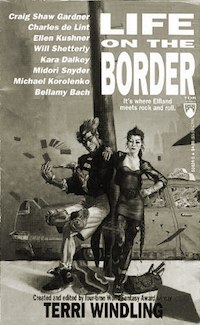This is another post that isn’t quite what it says on the label. The anthology, Life on the Border, is the other Bordertown book I hadn’t managed to get my hands on during my initial encounters with the series. So this wasn’t a reread for me, but a first read.
You can see things differently, without the haze of nostalgia. As a refugee from Minneapolis (the winters, people), I laughed a little to see it described as one of the hotspots for today’s youth culture in the introduction. There are things that change between writing and reading. It wasn’t Prince I saw play “Purple Rain” at First Ave., but Amanda Palmer. But that shift in perspective doesn’t make things less, it just makes things different. And my laugh was an ironic one because, while it wasn’t a Bordertown book that sent me to Minneapolis in the first place, the choice to move there was influenced by a book by one of the Bordertown writers.
The thing that allows for nostalgia in the first place is change. The recognition that you are different, and the past is not a thing that can be gone back to. Contemplating change is an excellent thing to be doing when reading Life on the Border, even if you are reading it for the first time.
The strength of Life on the Border is its thematic coherence. The idea of transformation is a powerful theme in the Bordertown stories, and it’s made most literal in this collection. Bordertown gets its name from being a city on a geographical border, between the Elflands and the World, but it is also a border between states of being for those who travel there. The stories in this collection are about choosing to be one thing or the other, about being caught between one shape, one state of being, one moment in life, and the next. They are about the gap—the border—between seeming and being.
The thematic coherence and the shared world aspect of the stories serve here as a foundation for the authors in this collection to work in a wide variety of genres. My favorite piece in the collection, Kara Dalkey’s “Nightwail,” is a beautiful ghost story. Michael Korolenko’s “Reynardine” is a fairy tale-inflected noir. They are as at home in Bordertown as urban fantasy and horror are, and it’s a testimony to the worldbuilding in the books that the setting is such a versatile stage.
But there was another commonality in the stories in this collection that made me a bit uncomfortable. One of the things I’ve always loved best about Bordertown is that it is a place for everyone. Humans, halfies, and elves could all come to the city and find a better life, and a better self to be. None were inherently better or worse then the other they were judged by behavior, not genetics.
Many of the stories in Life on the Border seem to be operating on the assumption that the elves are the villains. While there are individual elves who behave well rather than villainously, or who act with kindness to the humans or halfies in the stories, these are the exceptions. This struck an odd note for me, not because I believe that all elves are good—I’ve read too many of these stories for that—but because the idea that what someone is defines who they are is the sort of idea I remember the Bordertown stories writing against.
Beyond the thematic, the coherence of the book is also obvious at the level of story. Ellen Kushner’s “Lost in the Mail” is broken into small excerpts, and woven around the rest of the stories in the anthology. Will Shetterley’s “Nevernever” reintroduces Wolfboy and Leda, and tells more of their stories, and Midori Snyder’s “Allison Gross” not only reintroduces characters from “Demon,” her previous Bordertown story, it also introduces new characters and a new type of magic, both of which continue to reappear in the other stories in the volume. Charles de Lint’s “Berlin” and Bellamy Bach’s “Rain and Thunder” also provide different glimpses into the lives of characters they’ve written about before, and Craig Shaw Gardner’s “Light and Shadow” features familiar faces in supporting roles. Taken together, the stories are an elegant demonstration that a shared world is more than just a common setting, that it is an interwoven group of stories.
I wish I had read them before; I’m glad I read them now.
Kat Howard‘s short fiction has been published in a variety of venues. You can find her on Twitter, at her blog, and at Fantasy-matters.com. She still wants to live in Bordertown.










